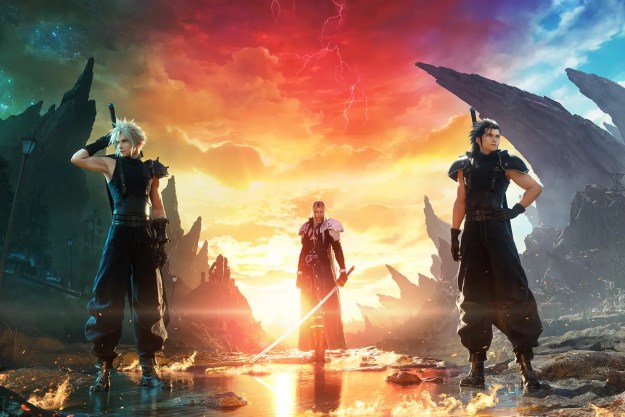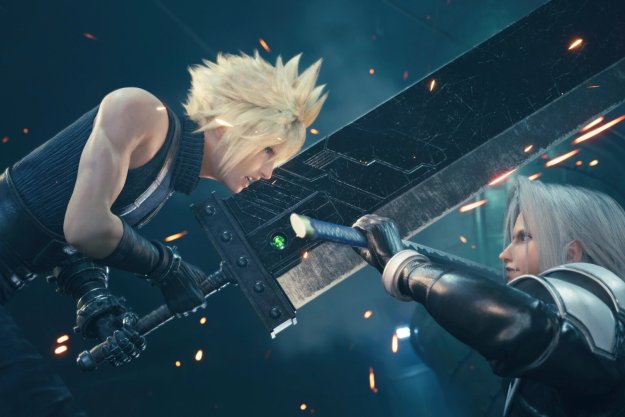
“Final Fantasy VII Rebirth is a phenomenal second chapter of what's shaping up to be an all-time great game trilogy.”
- Phenomenal story
- Strong performances
- Impactful combat tweaks
- Some excellent side-content
- A legendary soundtrack
- Repetitive open-world structure
When we last left the heroes of Final Fantasy VII Remake, they had defied their predetermined fates by killing the concept of destiny — literally. It was a triumphant victory but a short-lived one. As soon as their journey begins in Final Fantasy VII Rebirth, it’s clear that Cloud and company are facing off against a much tougher foe that threatens to doom their futures. It’s not Sephiroth; it’s themselves.
Despite having definitive control of their lives, the heroes of Gaia still struggle to overcome their own anxiety. Cloud believes he’s destined to become like his arch nemesis, and Barret is left panicking over how his smothering behavior will ruin his daughter’s life. The city of Midgar has fallen into collective despair, as its residents are convinced that there’s simply nothing anyone can do to save a dying world. The planet has fallen victim to a nihilism epidemic where hope is as scarce a commodity as Mako.
That narrative defines Rebirth, the emotional second chapter of Square Enix’s ambitious Final Fantasy VII remake trilogy. Rather than continuing the total meta-deconstruction of its predecessor, Rebirth is a more personal sequel about heroes who are terrified to become true masters of their own fate. For them, and perhaps players themselves, the inevitable feels inescapable — and that’s bad news for a certain flower peddler, whose future depends on everyone else getting their act together.
In another brilliantly self-reflexive action RPG, Final Fantasy VII Rebirth uses gaming’s most iconic bit of dramatic irony to fuel a deeply moving tale of self-doubt and personal rediscovery. It’s a bigger, at times less focused adventure, but one that leaves the kind of life-affirming imprint bound to make it another instant classic.
The unwritten future
Final Fantasy VII Rebirth picks up where Remake left off. Having escaped Midgar and the grip of fate itself, Cloud and his eclectic eco-terrorist pals set out on a world-spanning journey to hunt down the nefarious Sephiroth. The story sticks much closer to the original 1997 release’s script this time. The crew follows a familiar sequence of events, from marching in a military parade to racing Chocobo at the Gold Saucer, Gaia’s opulent amusement park. For those who felt like Remake spit in their memories, Rebirth offers a more faithful chapter that’s bound to be more of a nostalgic crowd-pleaser.
That’s not to say that it doesn’t mess with the original RPG. It’s very much still a self-aware remake that’s grappling with its legacy and the weight of overprotective fan expectations; it’s just doing so more inside the lines this time. Sequences like Barret’s face-off with Dyne, an old friend gone rogue, are given much more emotional depth here. It, and moments like it, are expanded to better tell a more emotionally resonant tale of heroes struggling to fight the grief, failure, and trauma of the past that threatens to define their future.
The slow-burn narrative pays off in tremendous fashion for those patient enough to see it through to the end.
What’s especially impressive is how Rebirth is able to deliver such fully realized character arcs for every party member. This time, the core quartet is joined by Red XIII, Yuffie Kisaragi, and Cait Sith, who are all playable in the sequel. That sounds like a mosh pit on paper, but every single hero gets the time they deserve. Each character has a significant moment to face their past while building a relationship with one another. That’s a testament to Rebirth’s expertly penned script, which turns the hodge-podge center of the original RPG into a self-contained story that functions apart from Remake.
Credit also goes to the voice cast, who turn in terrific performances across the board. Briana White gets more room to establish Aerith as a pure beacon of hope that’s imperative to protect. John Eric Bentley is terrific as Barret, deftly moving between moments of comedic relief and genuine heartache. Newcomer Paul Tinto especially steals the show as the feline prince Cait Sith, making Final Fantasy VII’s strangest character feel as human as anyone else.

Those human touches are crucial because Rebirth’s story can initially feel harder to grasp on to than the hyper-focused Remake. It hops around several plot threads over the course of 70 hours and takes its sweet time tying them together. Zack Fair, the Crisis Core star who miraculously escapes his fated death at the end of Remake, finds himself at the center of a gripping mystery that’s key to understanding the entire sequel on a thematic level, but it takes a long time to get there. That can feel exhausting in the moment, but the slow-burn narrative pays off in tremendous fashion for those patient enough to see it through to the end.
Rebirth doesn’t dance around the fact that most players and their mothers know the fate of our heroes in the original story. Instead of obscuring that history, it builds an incredibly tense story around it, one that puts players in the same headspace as Cloud and his companions. The end feels inevitable from the start. Even if the future is technically unwritten, why hope that anything could ever change? Rebirth’s ultimate power comes in how much it rallies players to overcome that pessimism and how it teaches them to keep pushing forward no matter what the outcome is. It’s a vital work for our current era of climate anxiety, a time where it’s easy to give up the fight and succumb to impending doom.
Finding synergy
Our heroes aren’t fighting their personal demons alone. Among its wealth of loaded themes, Rebirth is also a tale about disparate friends forming a strong support system. Those bonds are crucial to weathering the emotional battles of the Final Fantasy VII universe, so the sequel bakes that into its gameplay. While the core action RPG formula is largely unchanged from Remake, Square Enix makes several small tweaks here that give the entire sequel a greater sense of camaraderie.
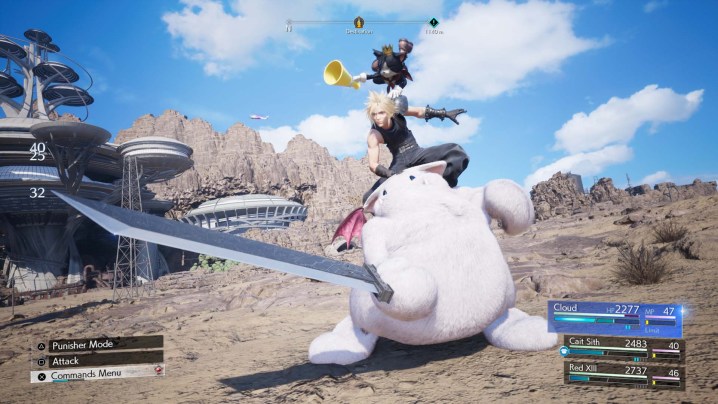
Look at its combat system, for instance. Rebirth features the same excellent action as its predecessor, cleverly paying tribute to the original’s turn-based combat with action-freezing commands that can be executed from a menu in the middle of fast, real-time fights. It’s still powered by a deep RPG system that has players creating perfect Materia combinations for each ally. Skills have been tweaked — they’re no longer tied to weapons, but broader character folios that grant permanent buffs — but the winning formula remains.
What’s changed, though, is how characters now interact with one another rather than fighting as lone wolves in the same arena. By holding down a bumper, each character can access a selection of abilities to perform duo attacks with active allies. Those can entirely broaden each hero’s playstyle. When I have Cloud active, I can have Barret shoot a bullet at his buster sword and deflect it into my foe. The more I work with my partners, the more efficient and versatile we are together.
With destiny dead, players have full control over their team.
That’s brought to an even greater conclusion with synergy abilities, which act as tandem limit breaks. When Barret and Cait Sith both have enough energy, they can team up and turn into a rotating merry-go-round of death. Those devastating bonus attacks can seriously turn the tides of battle, all while granting crucial support skills to allies. You don’t just master individual characters in Rebirth; you build party relationships that make everyone stronger.
Every small detail has some thematic significance. Compare the way party composition is handled between Remake and Rebirth. In the former, players never got to choose who was on their team. There was always a pre-selected trio in each encounter — a fitting decision for a game where our heroes were fighting for their free will. With destiny dead, players have full control over their team (except for a few key story missions that call for specific heroes). That makes Rebirth feel like a less restrictive adventure, offering players the freedom to build their characters through meticulous RPG customization.
The look and feel of Gaia
Freedom isn’t just core to combat; the entire shape of Rebirth comes from that concept. Where Remake placed players in linear halls that reminded them how little control they had over their claustrophobic fate, Rebirth smartly opts for more of an open-world approach. The vast planet is split up into six distinct biomes, each of which is a freely explorable space filled with checklist-driven map activities, sidequests, and minigames galore.
The almost overwhelming sense of adventure creates a perfect match for its now-dated predecessor, whose overworld ambitions feel smaller today than they did in 1997. Regions like Junon aren’t just empty fields loaded with blank space (a sin Final Fantasy XVI is guilty of). They’re richly detailed, with bits of environmental storytelling woven in that give a better sense of how the evil Shinra Corporation’s planet-draining operations are littering the natural world. It helps that Rebirth is a visual feat that takes full advantage of the powerful PS5. Every detail, from the dazzling neon lights of the Gold Saucer to the hilariously realistic dolphins of Junon, breathes new life into the world outside of Midgar.
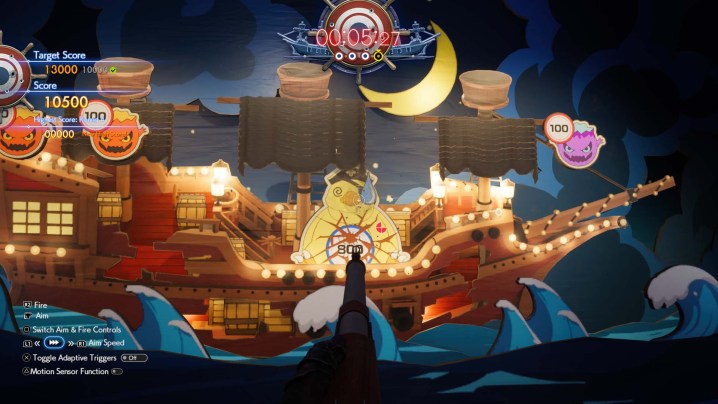
The almost Like a Dragon-esque approach to open-world design has its pros and cons. A lot of effort went into crafting meaningful side-content that builds out the eclectic attitude of the original. Some of those activities will keep players engrossed in entirely optional content. A wildly detailed piano-playing minigame has already won players over in Rebirth’s demo alone, but the real star is Queen’s Blood. That’s the RPG’s Gwent equivalent, an in-world deck-building card game that gets its own massive side plot. It’s absolutely fantastic, playing like a mix between Marvel Snap and Splatoon 3’s Tableturf Battles. More crucially, it allows Square Enix to paint a broader picture of life on Gaia. I learned so much about its various cities and their local eccentrics by chatting before a thrilling round of cards.
The enormous collection of content also gives composers Mitsuto Suzuki and Masashi Hamauzu plenty of opportunities to create memorable compositions that slot in along old classics. The result is astonishing. Rebirth features over 400 musical tracks and hardly a dud in the bunch. The soundtrack effortlessly swings between heart-wrenching orchestral ballads and gleefully weird synth ditties that play whenever I have to escort a dog through the woods. I don’t think I’m being overly effusive when I call it one of the all-time best video game scores.
Open-world exhaustion
While there’s a lot to love about Rebirth’s awe-inspiring scope, its weakest moments come from those open-world ambitions. It can be an exhausting journey at times that refuses to quit while it’s ahead. When I got to my fourth open area, the formula started to wear thin. Every single biome features the same exact checklist of simple activities. I can activate towers, find some hidden crystals, do a button-pressing memory minigame to gain summon data, fight through a list of simulated battles, and more. That formula doesn’t change much from area to area, which turns exploration into a repetitive chore by the time you reach the lush jungles of Gongaga — and there’s still so much more game after that point.
Its glut of content can feel hollow at moments …
A handful of charming but weak minigames further compounds that strain. Some are easy enough to skip, like a clunky 3D brawling minigame in the Gold Saucer. Others, unfortunately, are tied to great side stories. Intergrade’s dreaded reimagining of Fort Condor returns here, and it’s as frustrating as ever, but Rebirth one-ups that with a truly terrible robot tower defense minigame. I had already felt exhausted by the time I reached it, as I’d felt compelled to check off as many open-world activities as I could. That minigame was the straw that broke the camel’s back, crushing my will to see it all.
I’m of two minds when it comes to Rebirth’s bloated structure. Its glut of content can feel hollow at moments, dragging out a riveting story with hours of repetitive diversions. But even then, there’s a function in that structure. When The Legend of Zelda: Breath of the Wild came out, I remember having several conversations where friends told me they refused to beat it. They simply weren’t ready to leave a world they loved so dearly, so they’d dedicated as much time as they could to completing every shrine or finding every Korok seed. As long as they never fought Calamity Ganon, they could stave off the inevitable credits roll forever.
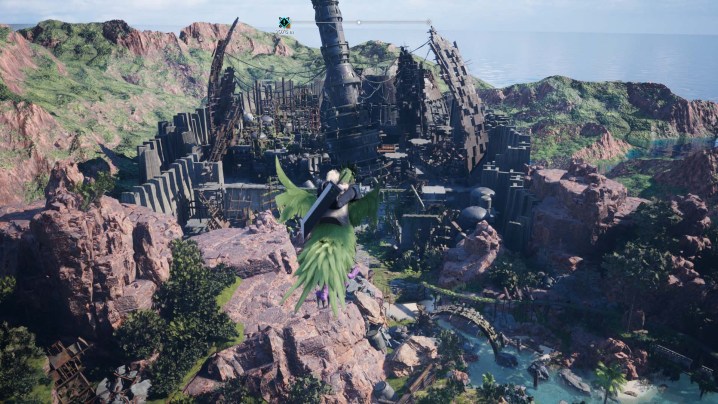
I had that same feeling playing Rebirth, but not because I didn’t want to put down a game I loved. I feared what awaited me in its final chapter. An ever-present dread hangs over Rebirth, even in its brightest moments. The possibility of a grand, traumatic failure looms like thick smoke from a Shinra reactor. I was determined to change that outcome, but what if I couldn’t? Would I be ready to accept that I can still be powerless in a world without fate? Maybe I’d never have to face that reality if I dedicated my life to Chocobo Racing or perfecting my Queen’s Blood deck.
Final Fantasy VII Rebirth leads both its heroes and players on a quest for self-acceptance. That’s not something you can rush. One can only face their worst fear when they’re ready to accept that their life does not need to be defined by a singular success or failure. The future is unwritten. After all, we still have a trilogy to finish.
Final Fantasy VII Rebirth was tested on a PS5 hooked up to a TCL 6-Series R635.
Editors' Recommendations
- Tribeca Games 2024 will feature 7 games and a Final Fantasy 7 panel
- Final Fantasy 7 Rebirth: all piano sheet music locations and rewards
- The best ways to farm Gil in Final Fantasy 7 Rebirth
- The best armor in Final Fantasy 7: Rebirth
- Final Fantasy 7 Rebirth preload guide: release time, file size, and preorder





